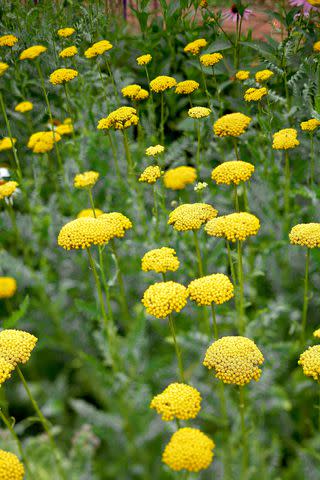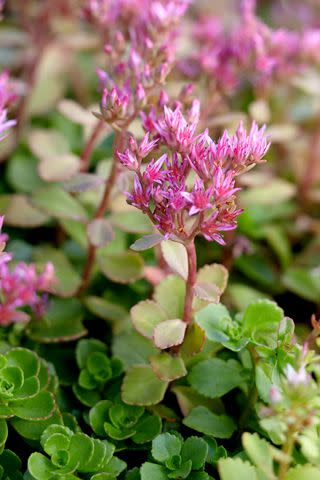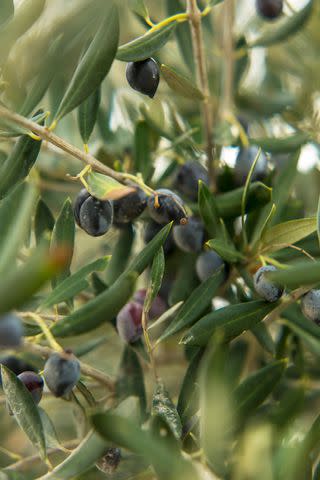10 Best Lavender Companion Plants
Grow a lower maintenance edible or flower garden with these top lavender companion plants.

Lavender is one of the most popular herbs to grow in pollinator gardens, fragrance gardens, container gardens and, of course, herb gardens. With a strong fragrance and sturdy leaves and stems, lavender is naturally resistant to most pests, which is why it is a common companion plant to keep in vegetable and flower gardens. Because lavender has low watering needs, it's important to choose companion plants that also thrive in drier soil. In the list below, you’ll find the top companion plants for lavender and details about how to grow these plants together in gardens and containers.
The best companion plants for lavender tend to be plants that also need full sun, minimal water, and well-draining soil with a low nutrient content.
Rosemary

Rosemary and lavender make excellent companion plants because they have very similar growing needs. Both plants are native to the Mediterranean region and they grow best in full sun and well-draining soil that is slightly alkaline and not overly rich. Keeping these plants together just makes a lot of sense, especially because they can both grow in inground beds or containers. Just keep in mind that most types of rosemary are less winter hardy than lavender and it is often kept as an annual in cooler locations.
Roses

Roses and lavender are commonly grown together in fragrance gardens and cottage gardens, where the plants’ different textures and flower colors complement each other beautifully. Plus these plants have similar growing needs. You can also find compact rose varieties to grow in pots with lavender, or you can grow both in a mixed bed arrangement for lots of color. Lavender’s strong scent even may help protect your roses from some pests such as deer.
Related:17 of the Most Fragrant Roses for Sweet Scents All Season Long
Yarrow

Like lavender, yarrow also thrives in full sun and well-drained soil and it is a relatively drought-tolerant perennial too. When grown in very rich earth, yarrow has the tendency to spread like a weed, but if it’s kept in the low nutrient soils that lavender grows best in, yarrow is a much more manageable plant. Both yarrow and lavender are top pollinator plants as well.
Thyme

Thyme is another aromatic herb from the Mediterranean region and, like rosemary and lavender, it doesn’t need a lot of extra water. It is also used in the herbs de Provence blend with lavender, so you need to grow it if you want to make your own seasoning. Thyme is more cold hardy than rosemary, which makes it a perfect lavender companion plant in cooler climates. Additionally, lower growing thyme varieties, such as creeping thyme, can be grown as low-maintenance groundcovers to suppress weeds around your lavender plants.
Sedum

Sedum is another plant that has low watering needs, which makes it a fine partner for lavender. Sedum also begins to flower late in the season and will provide pollen and nectar for pollinators in autumn, long after lavender flowers have faded. There are hundreds of different sedums to choose from, including some low growing varieties that can be used as a groundcover around lavender plants to suppress weeds and conserve soil moisture.
Brassicas

Brassicas, including broccoli, cauliflower, and cabbage, are some of the tastiest and most nutritious vegetables you can grow in your garden. However, brassica vegetables are also very appealing to pest insects and they are often targeted by cabbage loopers, slugs, and snails, which will riddle brassica leaves with holes. Growing lavender near brassica plants can reduce pest activity and keep your veggies looking their best. However, because lavender has lower moisture needs than brassicas, you may want to plant lavender in pots in your vegetable garden so you can keep the soil a bit drier for this herb.
Related:10 Best Companion Plants for Broccoli
Coneflowers

Coneflowers are classic pollinator plants and their large seed heads provide an important food source for wild birds in autumn and winter. But if you’re looking for a good companion plant for lavender, coneflowers may be the choice for you. Not only do these two plants have similar growing needs, but their flowers coordinate beautifully in ornamental beds while attracting bees and butterflies.
Sage

Sage is another aromatic herb that has the same growing needs as lavender. Sage can be grown in both pots and inground beds and it can be used in conjunction with lavender to keep pests, like carrot flies and cabbage moths, out of ornamental and vegetable gardens. While you can grow common sage, if you prefer bolder plants, you may want to try out tricolor or purple sage plants that have even more colorful leaves.
Oregano

Oregano is yet another herb that tolerates drier soil and is even more cold hardy than lavender. This low maintenance plant grows exceptionally well when paired with lavender. And if you allow it to bloom, it will produce a flush of pretty, purple flowers that will complement your lavender plants.
Olives

John Bessler
Olives aren’t as commonly grown as some other edible plants, but if you live in a warmer climate, you can keep lavender and olives together. Like lavender, olive trees prefer well-drained soil that is relatively alkaline and they grow best in areas with hot summers and mild winters. Not to mention, the soft green leaves of olive trees look very stately when grown beside the silvery-green foliage of lavender plants.
Related:23 Lavender Varieties for a Fragrant Garden Wherever You Live
For more Better Homes & Gardens news, make sure to sign up for our newsletter!
Read the original article on Better Homes & Gardens.

